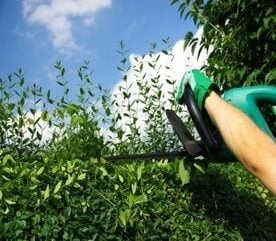Landscaping Ideas for a Greener Garden Next Spring
Fall doesn’t have to be the end of the gardening season. Instead, consider it to be the start of next year’s garden; an opportunity to get started on new landscaping ideas! But along with the pleasure of enjoying the outdoors in these cooler temperatures, certain tasks are important this time of year for a number of reasons. Besides the obvious cleaning and tidying up for aesthetic appeal, having a healthy lawn and garden next spring that is naturally “greener” begins with steps you should take right now!

Cutting Back and Cleaning Up
Many pests and diseases overwinter in plant debris. Removing it from the landscape now improves your chances of eliminating problems that would otherwise reemerge next spring. As you clean and green up your outdoor space this fall, include the following yard-work to-dos:
• Cutback and perennials. Perennial plants come back next year because the roots survive, even though the aboveground growth may not. Cutting off the foliage a few inches above the ground in the fall will not harm the plant. Some gardeners, however, prefer to leave non-diseased or insect-infested perennials be, as it adds winter interest and provides food for the birds in the lean months.
• Remove spent annuals and seasonal vegetables. Unlike perennials, annuals do not come back year after year, so there is no reason to leave these in the ground. Pull them up, roots and all, and add to your compost pile.
• Remove weeds and leaf debris. These are common places for diseases and pests to overwinter. The less hospitable you can make the garden for winter-hardy pests, the fewer problems you’ll have to deal with in spring.
• Compost only the healthy material. As you remove debris from your fall cleanup projects, be sure to add only pest-free and non-diseased plants to the compost pile. Destroy any diseased plant material, or remove it from your garden. Pathogens and insect pests can overwinter and return next year in compost that doesn’t get hot enough.
Protect and Prepare
With cooler temperatures on the way, now’s the time to bundle up the backyard. Here are a few backyard landscaping ideas you can do now that will benefit your yard and garden come spring.
• Get a soil test. Fall is a great time to amend your soil. Information provided by a soil-test report can tell you what’s needed. Most reports include details, such as pH and a nutrient analysis of the basic elements. Look for certified private labs that provide information on how to supplement amendments using organic and natural options. Most university labs that provide the testing for county Extension services still provide only synthetic-chemical recommendations. Visit our “Links” index at BackyardLivingmagazine.com for information.
• Amend the soil with natural, organic materials. Even without the help of a soil test, organic amendments, such as homemade compost, manure, blood meal, bone meal, cottonseed meal and greensand are a great way to improve the long-term health and structure of soil naturally. By adding them in fall, amendments have time to break down into a form that plants can use, just in time for spring.
• Add mulch. A fresh layer of mulch provides a protective barrier over plant roots and protects evergreen foliage from soil-borne diseases that can splash back onto them. In colder climates, add mulch after the ground freezes. This will help prevent frost heave and keep soil temperatures more even through winter, while protecting roots. As the mulch decomposes, that all-important, soil-improving organic matter is enriching your garden beds as well.
• Protect trees and shrubs from pests. Many damaging insects feed in early spring, often before we’ve had a chance to react. Although there are good natural solutions, such as horticultural oils and insecticidal soap, proper timing and direct contact are important for control. Fall’s a good time to manage spring pests proactively using more environmentally friendly systemic insecticides. Although not organic, systemic chemicals are applied around the root zone and drawn up into the tissue of treated plants and trees, greatly reducing the risk of contact to beneficial and neutral insects. Pests come in contact with the chemical whenever the plant tissue is breached, eliminating the need for proper timing and exposure risk to “the good guys” through direct contact.
• Winterize containers. Not all plants or containers are able to withstand the winter outdoors. Containers can freeze and crack, and non-hardy plants quickly die when roots are exposed to the elements. Plants lost to the cold can be composted, but what do you do with the broken containers? Undoubtedly, they’ll be headed for the landfill. To protect plants and containers, bring them inside or at least to an area protected from winds and extreme temperatures. A garage or basement works well in many cases. For added protection, wrap the container in blankets or plastic wrap, several layers thick. You don’t want to encourage new growth during this time, so don’t add fertilizer and keep water to a minimum.
The bottom line to the extra effort we put into our outdoor spaces this fall is big dividends next year as we enjoy healthier gardens and landscapes. By acting on the tasks listed above now, our soil and the plants growing in it, including lawns, will have a greater resistance to the forces that might otherwise require more drastic measures. Not only will our landscapes look greener, they’ll be greener-naturally. And that means less work next spring and beyond. I’d say that’s not a bad tradeoff.



